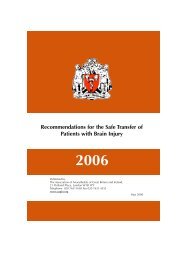TheatrePracticeStandardsGeneric1
You also want an ePaper? Increase the reach of your titles
YUMPU automatically turns print PDFs into web optimized ePapers that Google loves.
Generic Theatre Standard No 06 - Management of Patients with<br />
known Infections or carriers of Infectious Agents<br />
Standard Statement: All Theatre staff will have knowledge of the requirements for caring for<br />
patients with known Infections or carriers of Infectious Agents in the operating department to<br />
protect self, colleagues and patients from the risk of health care acquired infection.<br />
General considerations<br />
• Training all staff involved in the care of the patient must be aware of the specific<br />
precautions and have received adequate training.<br />
• Briefing should include a quick check to ensure all staff are aware of the specific<br />
precautions, patient’s position on the list, recovery time/place and sufficient<br />
environment/equipment cleaning time all should be highlighted and discussed.<br />
• Communication is absolutely essential prior to handover, so the next healthcare team<br />
have the ability to instigate isolation procedures, as necessary.<br />
• Flow The essence of this is maintaining adherence with infection control policy but also<br />
maintaining flow through our theatres. Sensible and thoughtful application with<br />
discussion between all care givers will allow for better flow.<br />
• In order to limit accidental exposure good theatre practice/technique includes keeping<br />
staff to a minimum, trying to reduce unnecessary movement of personnel from one zone<br />
to another, raising awareness and keeping only the equipment/items relevant for the<br />
surgery taking place in the theatre. Standard precautions must be adhered to. The<br />
theatre doors must be kept closed to aid the efficiency of the ventilation systems. As far<br />
as possible all personnel, surgical instruments and sundries must be sourced prior to the<br />
case being undertaken.<br />
• Recovery PACU Known infectious patients do not always need to be recovered in<br />
theatre. Safety gel, granules/sachets to be used when transporting possibly infected<br />
fluids, e.g. urine from the bay to the sluice. Appropriate communication with the recovery<br />
team must occur to ensure that they are informed of the patient’s status. The recovery<br />
bay and all equipment must be cleaned following transfer to the ward. Recovery staff<br />
must ensure that the receiving ward is fully aware of infectious status, in a timely manner<br />
to allow the receiving ward to make any necessary arrangements.<br />
• Waste Contaminated PPE and clinical waste disposed into yellow bags for incineration.<br />
Contaminated clothing and reusable bedding disposed into red bags for infected<br />
laundering. Safety gel/granules to be applied to spillages or when carrying possibly<br />
infected bodily fluids from theatre to sluice and when disposing, to prevent splash back.<br />
Please see individual standards for or specific guidance on<br />
• Staff risk<br />
• Patient position on list schedule<br />
• Hand Hygiene<br />
• Personal Protective Equipment (PPE)<br />
• Environment/equipment cleaning<br />
• Recovery PACU instructions<br />
Quick-view chart on list position and recovery placement for each infectious agent can be<br />
seen below.<br />
Compliance: 100%<br />
Exceptions: None<br />
26





